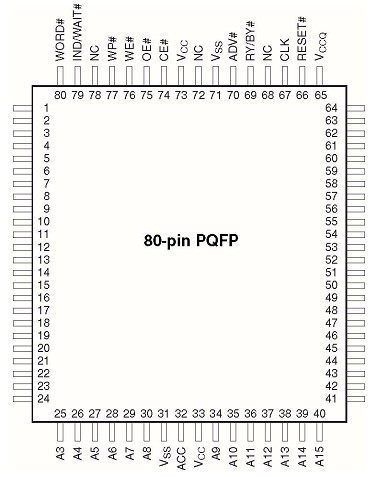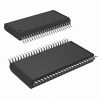Features: Persistent Sector Protection
- A command sector protection method to lock combinations of individual sectors and sector groups to prevent program or erase operations within that sector (requires only VCC levels)
Password Sector Protection
- A sophisticated sector protection method to lock combinations of individual sectors and sector groups to prevent program or erase operations within that sector using a user-defin-able 64-bit password
Supports Common Flash Interface (CFI)
Unlock Bypass Program Command
- Reduces overall programming time when issuing multiple program command sequences
Data# Polling and toggle bits
- Provides a software method of detecting program or erase operation completion Pinout SpecificationsStorage Temperature
SpecificationsStorage Temperature
Plastic Packages. . ........ . . . . . . . . . . .65°C to +150°C
Ambient Temperature
with Power Applied . . . .... . . ............. 65°C to +145°C
VCC , VIO (Note 1) . . . . . . . . .............. . .0.5 V to + 3.0 V
ACC, A9, OE#, and RESET# (Note 2) . . .0.5 V to +13.0 V
Address, Data, Control Signals
(with the exception of CLK) (Note 1)............ 0.5 V to 3.6
All other pins (Note 1) . . . . . . ........... . . .0.5 V to +5.5 V
Output Short Circuit Current (Note 3) . ........... . . . 200 mA DescriptionThe Am29BDD160 is a 16 Megabit, 2.5 Volt-only single power supply burst mode flash memory device. The device can be configured for either 1,048,576 words in 16-bit mode or 524,288 double words in 32-bit mode. The device can also be programmed in standard EPROM programmers. The device offers a configurable burst interface to 16/32-bit microprocessors and microcontrollers.
To eliminate bus contention, each device has separate chip enable (CE#), write enable (WE#) and output enable (OE#) controls. Additional control inputs are required for synchronous burst operations: Load Burst Address Valid (ADV#), and Clock (CLK).
Each Am29BDD160 requires only a single 2.5 or 2.6 Volt power supply (2.5 V to 2.75 V) for both read and write functions. A 12.0-volt V
PP is not required for program or erase operations, although an acceleration pin is available if faster programming performance is required.
Am29BDD160 is entirely command set compatible with the JEDEC single-power-supply Flash standard. The software command set is compatible with the command sets of the 5 V Am29F and 3 V Am29LV Flash families. Commands are written to the command register using standard microprocessor write timing. Register contents serve as inputs to an internal state-machine that controls the erase and programming circuitry. Write cycles also internally latch addresses and data needed for the programming and erase operations. Reading data out of the device is similar to reading from other Flash or EPROM devices.
The Unlock Bypass mode facilitates faster programming times by requiring only two write cycles to program data instead of four.
The Simultaneous Read/Write architecture provides simultaneous operation by dividing the memory space into two banks. The device can begin programming or erasing in one bank, and then simultaneously read from the other bank, with zero latency. This releases the system from waiting for the completion of program or erase operations. See Simultaneous Read/Write Operations Overview and Restrictions on page 13.
Am29BDD160 provides a 256-byte SecSi
(TM) (Secured Silicon) Sector with an one-time-programmable
(OTP) mechanism.
In addition, the device features several levels of sector protection, which can disable both the program and erase operations in certain sectors or sector groups: Persistent Sector Protection is a command sector protection method that replaces the old 12 V controlled protection method; Password Sector Protection is a highly sophisticated protection method that requires a password before changes to certain sectors or sector groups are permitted; WP# Hardware Protection prevents program or erase in the two outermost 8 Kbytes sectors of the larger bank.
Am29BDD160 defaults to the Persistent Sector Protection mode. The customer must then choose if the Standard or Password Protection method is most desirable. The WP# Hardware Protection feature is always available, independent of the other protection method chosen.
The Versatile I/O(TM) (VCCQ) feature allows the output voltage generated on the device to be determined based on the V
IO level. This feature allows this device to operate in the 1.8 V I/O environment, driving and receiving signals to and from other 1.8 V devices on the same bus. In addition, inputs and I/Os that are driven externally are capable of handling 3.6 V.
The host system can detect whether a program or erase operation is complete by observing the RY/BY# pin, by reading the DQ7 (Data# Polling), or DQ6 (toggle) status bits. After a program or erase cycle has been completed, the device is ready to read array data or accept another command.
The sector erase architecture allows memory sectors to be erased and reprogrammed without affecting the data contents of other sectors. The device is fully erased when shipped from the factory.
Hardware data protection measures include a low V
CC detector that automatically inhibits write operations during power transitions. The password and software sector protection feature disables both program and erase operations in any combination of sectors of memory. This can be achieved in-system at V
CC level.
The Program/Erase Suspend/Erase Resume feature enables the user to put erase on hold for any period of time to read data from, or program data to, any sector that is not selected for erasure. True background erase can thus be achieved.
The hardware RESET# pin terminates any operation in progress and resets the internal state machine to reading array data.
Am29BDD160 offers two power-saving features. When addresses have been stable for a specified amount of time, the device enters the automatic sleep mode. The system can also place the device into the standby mode. Power consumption is greatly reduced in both these modes.
AMD's Flash technology combines years of Flash memory manufacturing experience to produce the highest levels of quality, reliability and cost effectiveness. The device electrically erases all bits within a sector simultaneously via Fowler-Nordheim tunnelling. The data is programmed using hot electron injection.

 Am29BDD160 Data Sheet
Am29BDD160 Data Sheet







